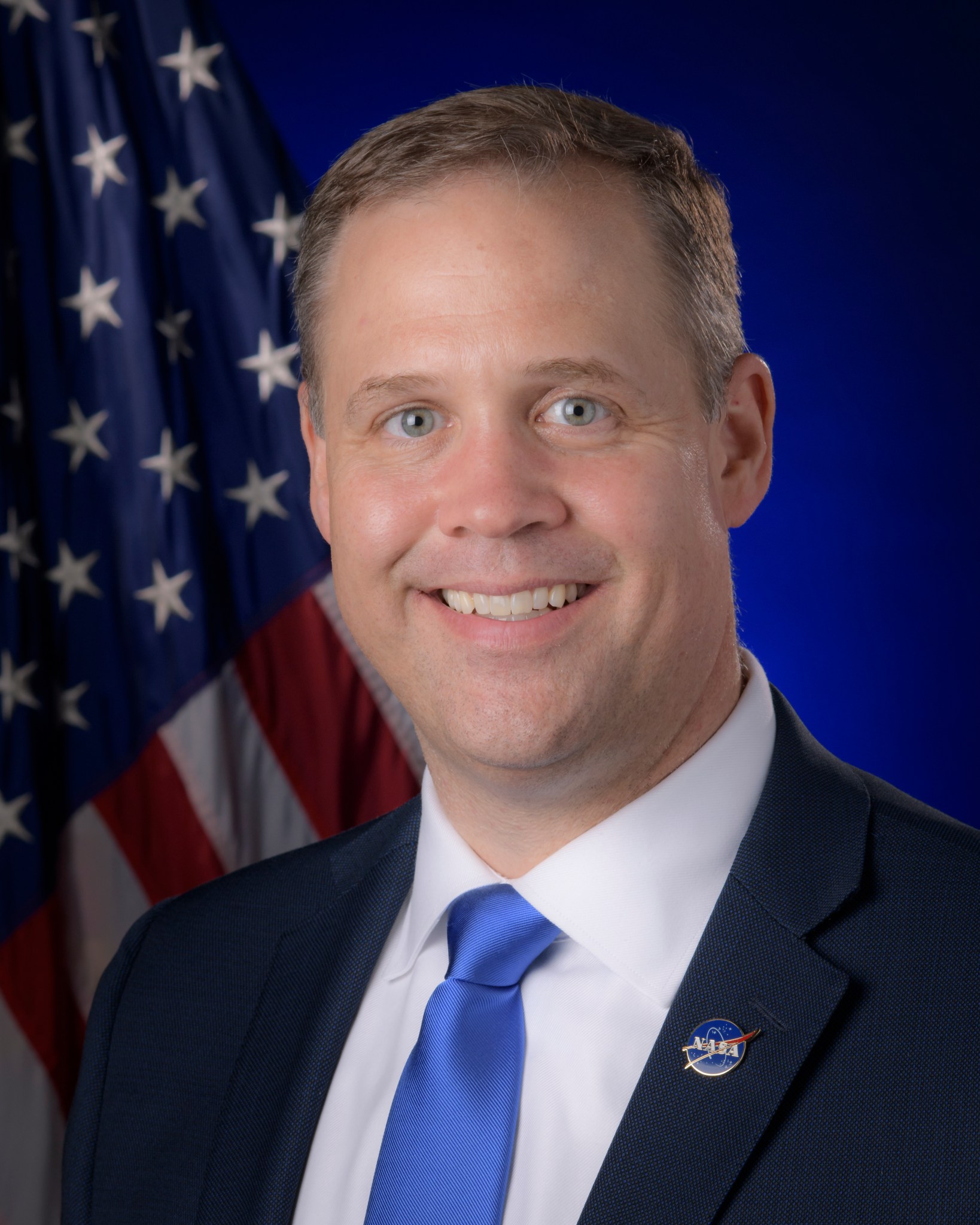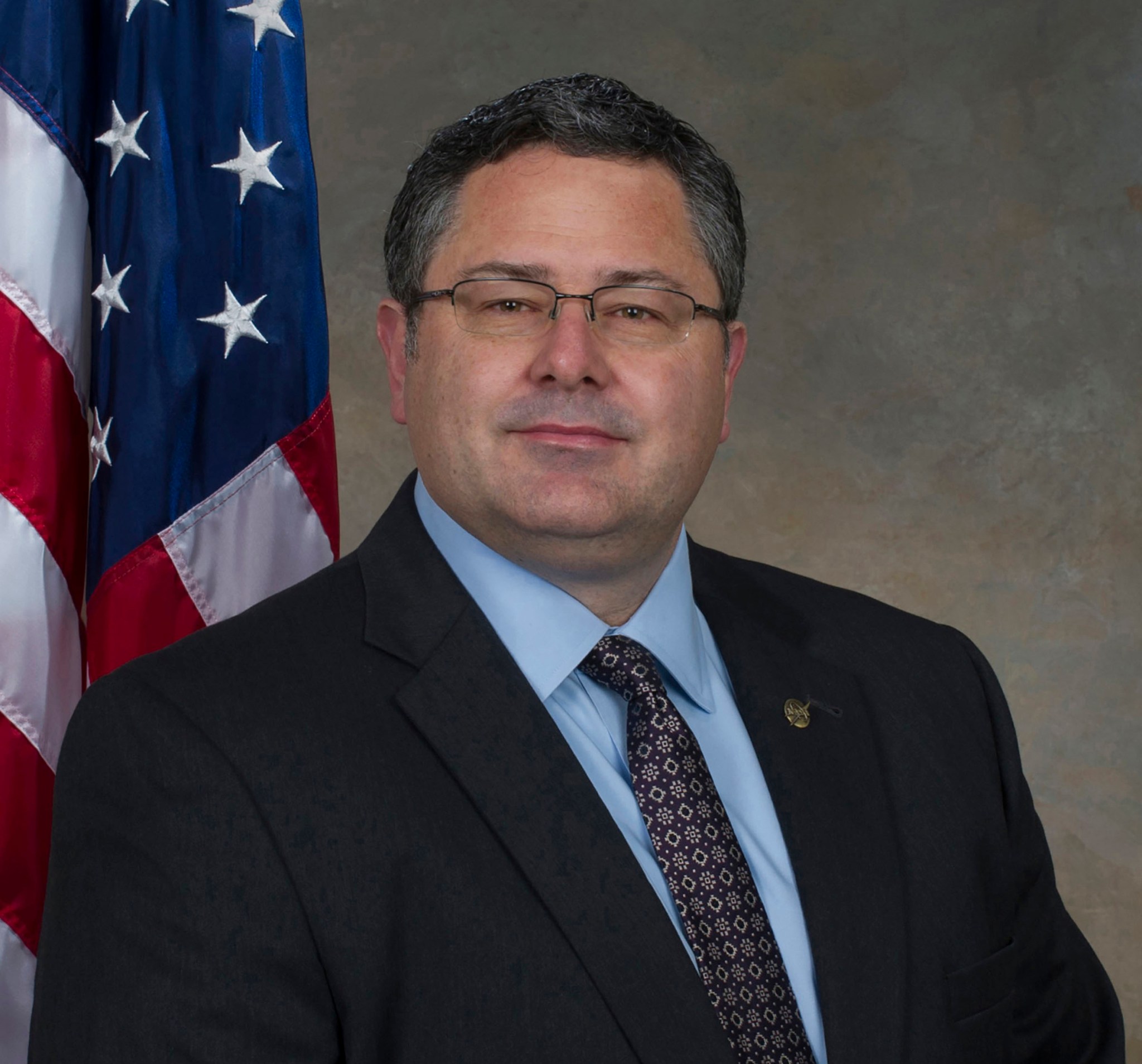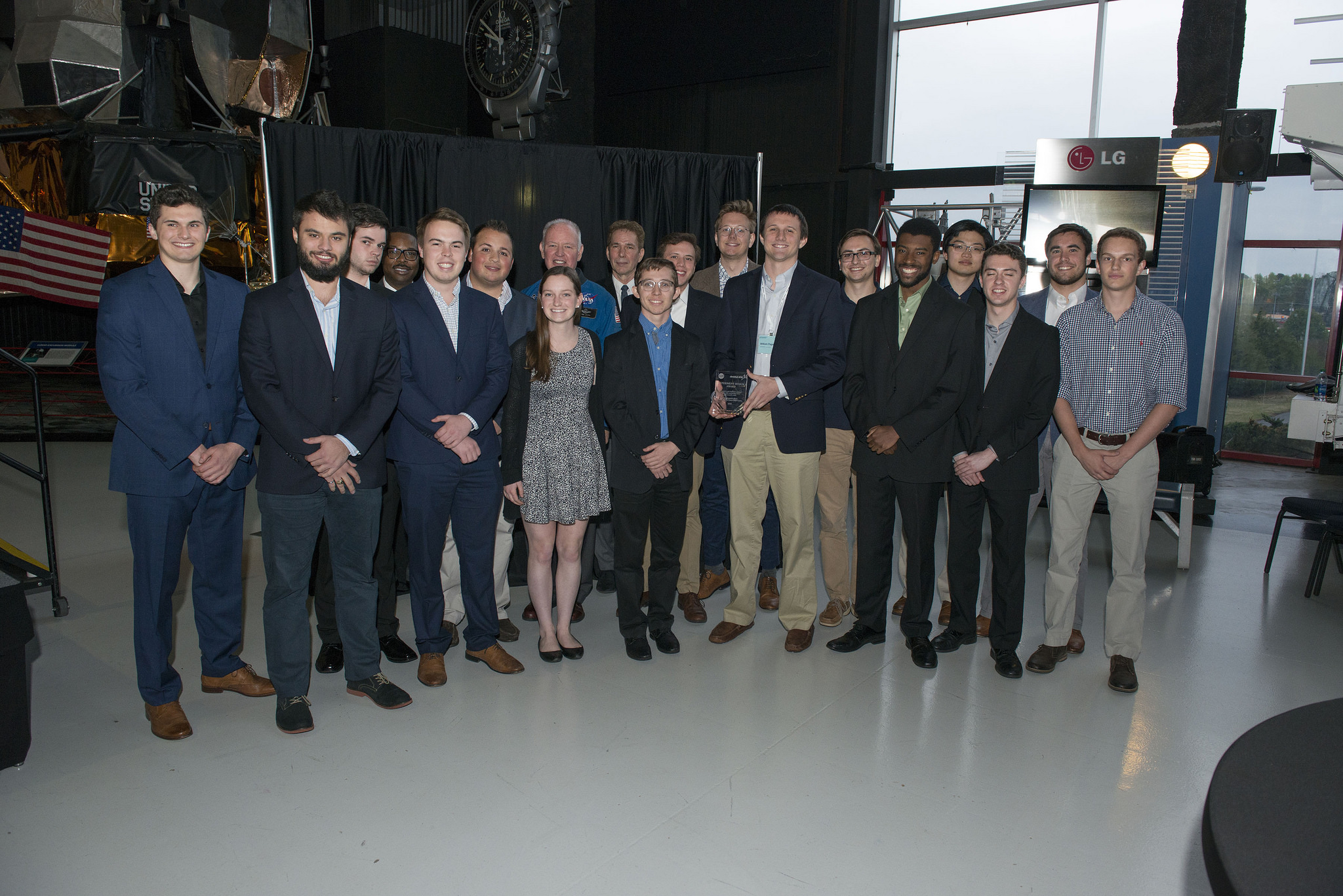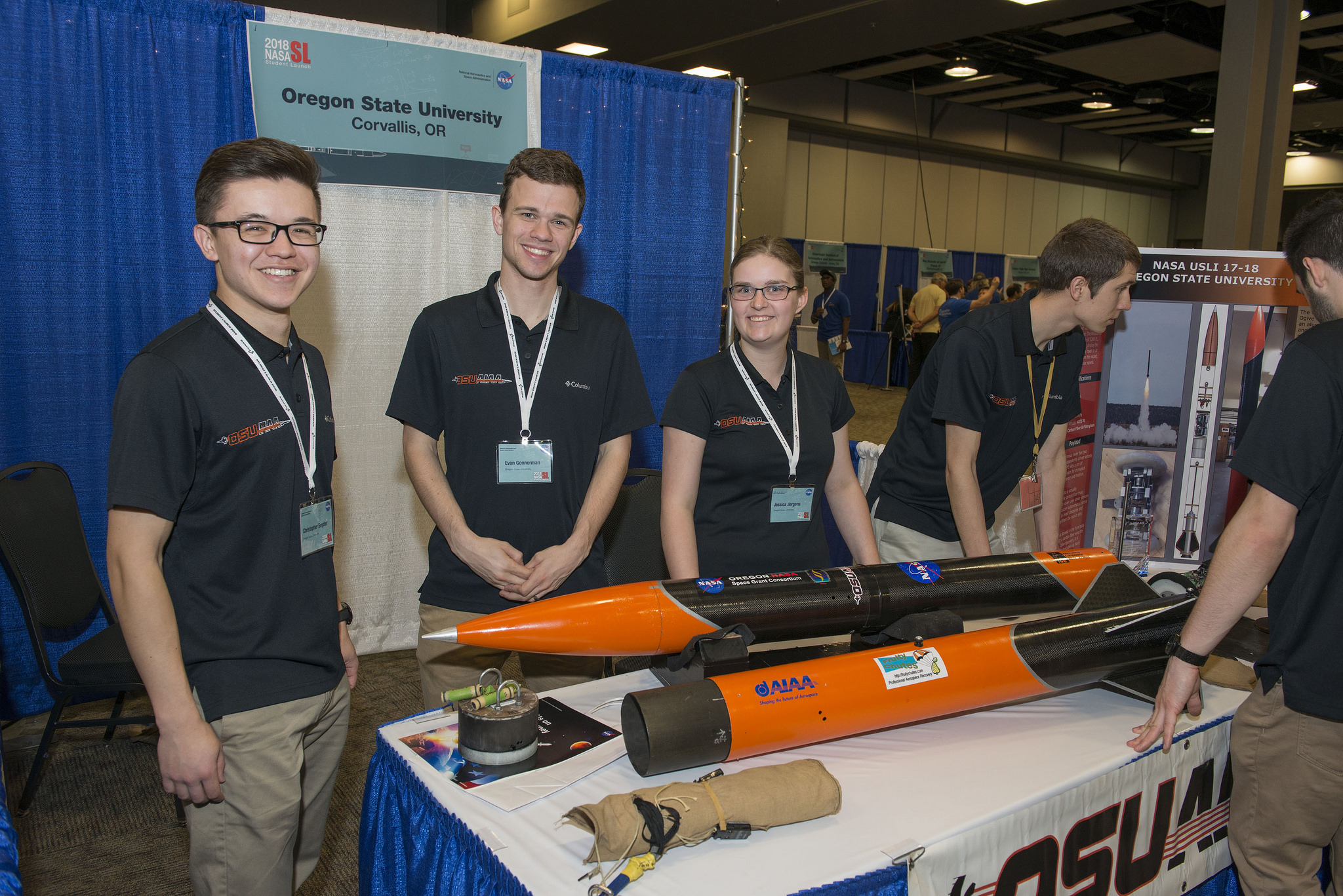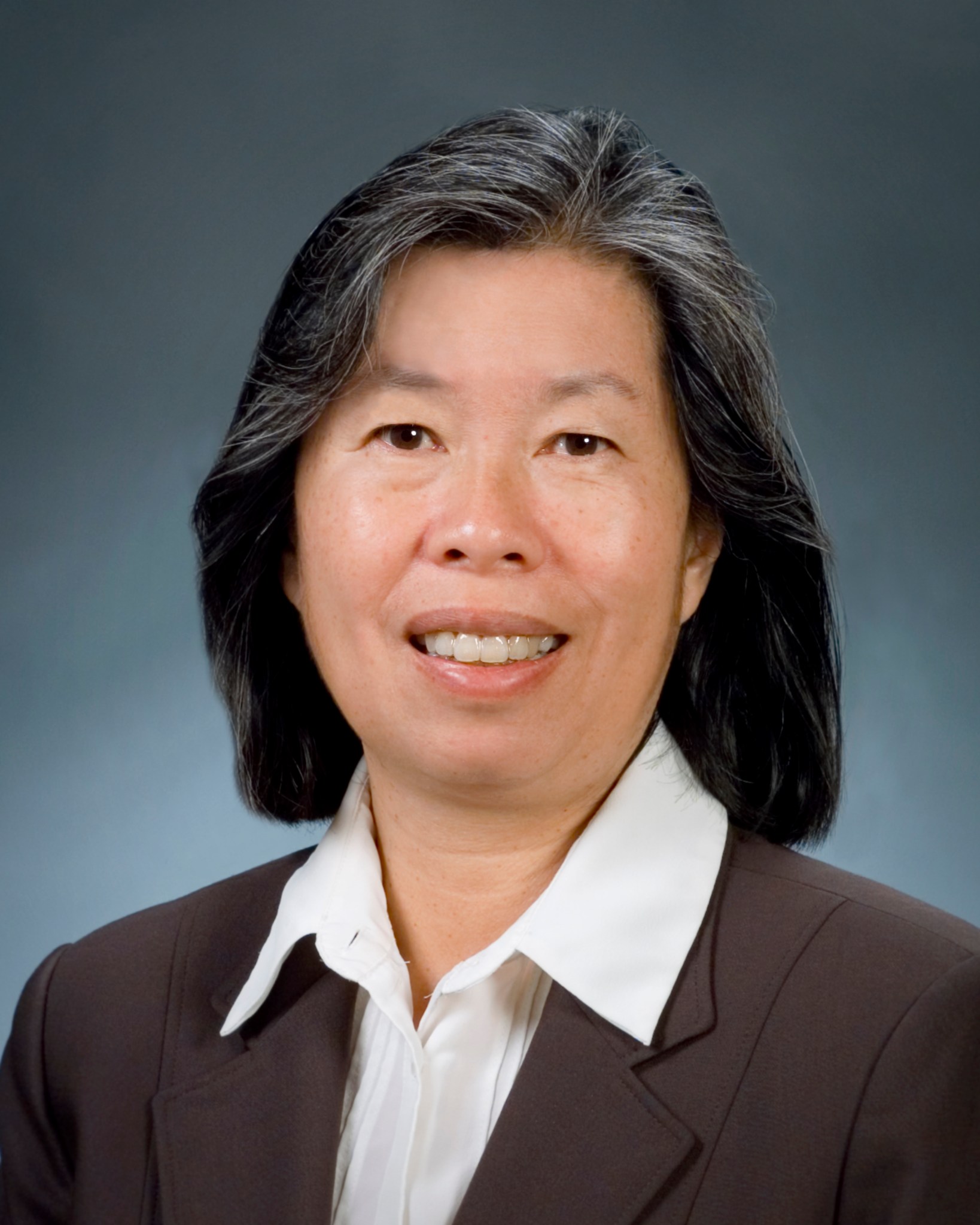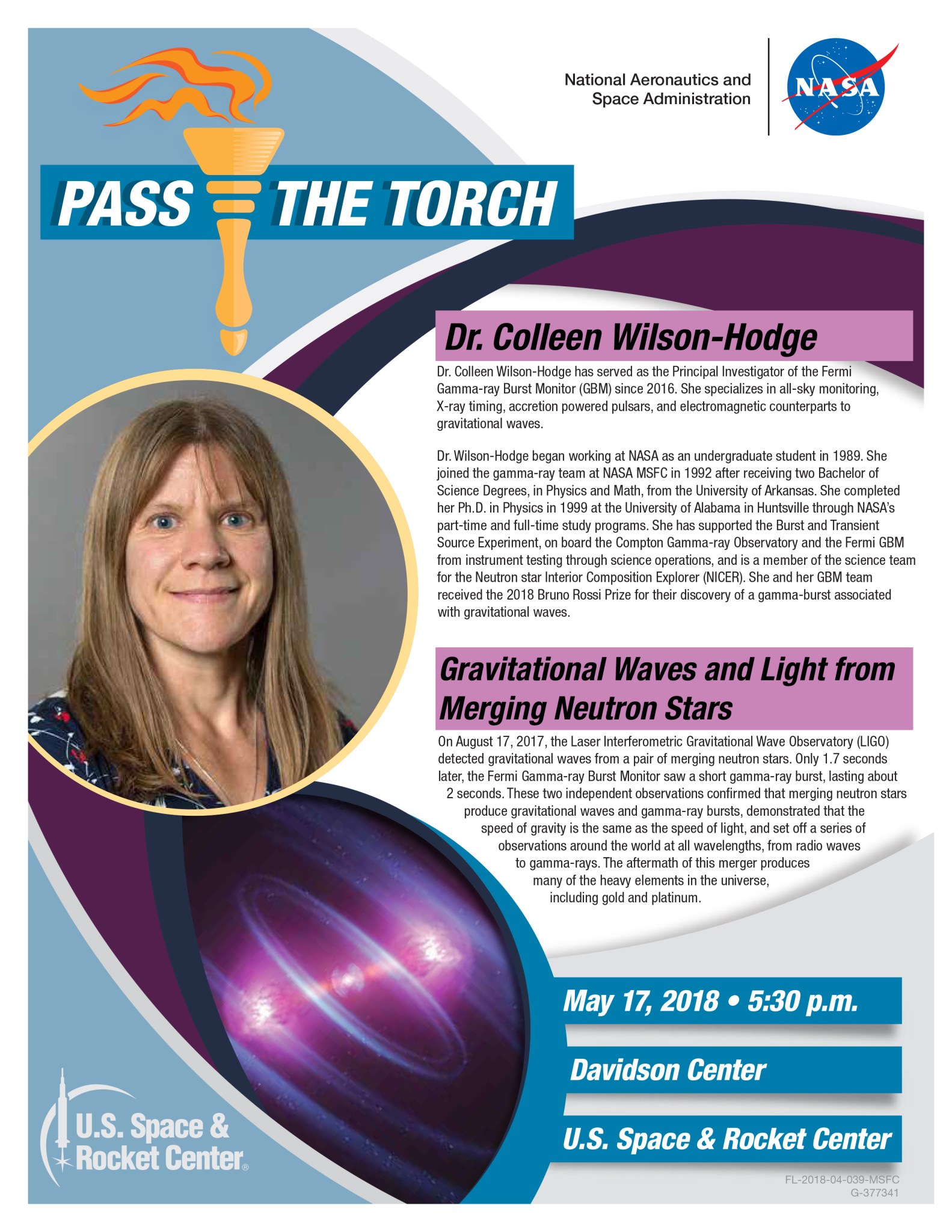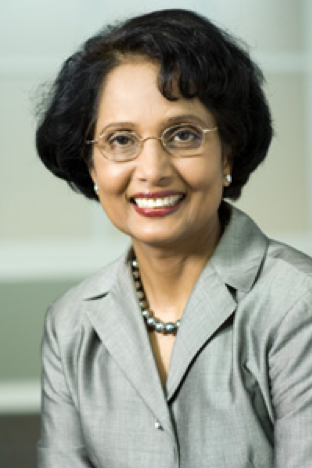In This Week’s Star
- Town Hall with NASA Administrator Jim Bridenstine May 17, Followed by All-Hands With Marshall Director Todd May
- When Thousands of Alabama Students Call, Marshall Answers
- NASA Announces Winners of 2018 Student Launch Competition
- Glenn Research Center’s Anita Laing to Share Keys to Mission Success at Shared Experiences Forum May 17
- Marshall Astrophysicist Colleen Wilson-Hodge to Speak at U.S. Space & Rocket Center’s Pass the Torch Series
- Marshall to Celebrate Asian American and Pacific Islander Heritage Month
- This Week in NASA History: Apollo 10 Launches – May 18, 1969
- Obituaries
Town Hall with NASA Administrator Jim Bridenstine May 17, Followed by All-Hands With Marshall Director Todd May
NASA Headquarters will host the first agencywide town hall with NASA Administrator Jim Bridenstine May 17, from 10-11 a.m. CDT. Directly following Bridenstine’s address, NASA Marshall Space Flight Center Director Todd May will hold a center all-hands meeting.
Marshall team members will be able to view Bridenstine’s streamed address in Building 4200’s Morris Auditorium, or through NASA or desktop TV. The all-hands with May will be in Morris and on desktop TV immediately after the town hall meeting.
May will update the workforce about the NASA 2018 Strategic Plan; readying the Space Launch System rocket for the first mission, Exploration Mission-1; moving forward with the International Space Station; launch of the InSight Mars Lander, and acknowledgement of the Marshall team that worked on it; and a review of leadership changes around Marshall. If time permits, May will answer questions at the end of the all-hands meeting. To submit questions for May, email ms-msfc-employeecomm@mail.nasa.gov.
You may also submit questions to the NASA administrator securely from any computer or mobile device from now until the end of the presentation.
To submit a question for the administrator:
- Go to https://www.nasa.gov/townhall
- Enter the check-in code for this session: th2018!
- Enter Marshall Space Flight Center
- Click “Ask” or, if your question is already on the list, vote it up the list by clicking the arrow on the left.
When Thousands of Alabama Students Call, Marshall Answers
By Jonathan Deal
Using popular science fiction to inspire the next generation of scientists and engineers, NASA Marshall Space Flight Center team members embraced the May 4 tradition of celebrating the “Star Wars” movies and the films’ catchy phrase, “May the Force be with You.”
About two-dozen Marshall scientists and engineers took to the road May 4 to share NASA’s exhilarating message with more than 4,000 students in grades one through six at eight schools in the Birmingham, Alabama, area.
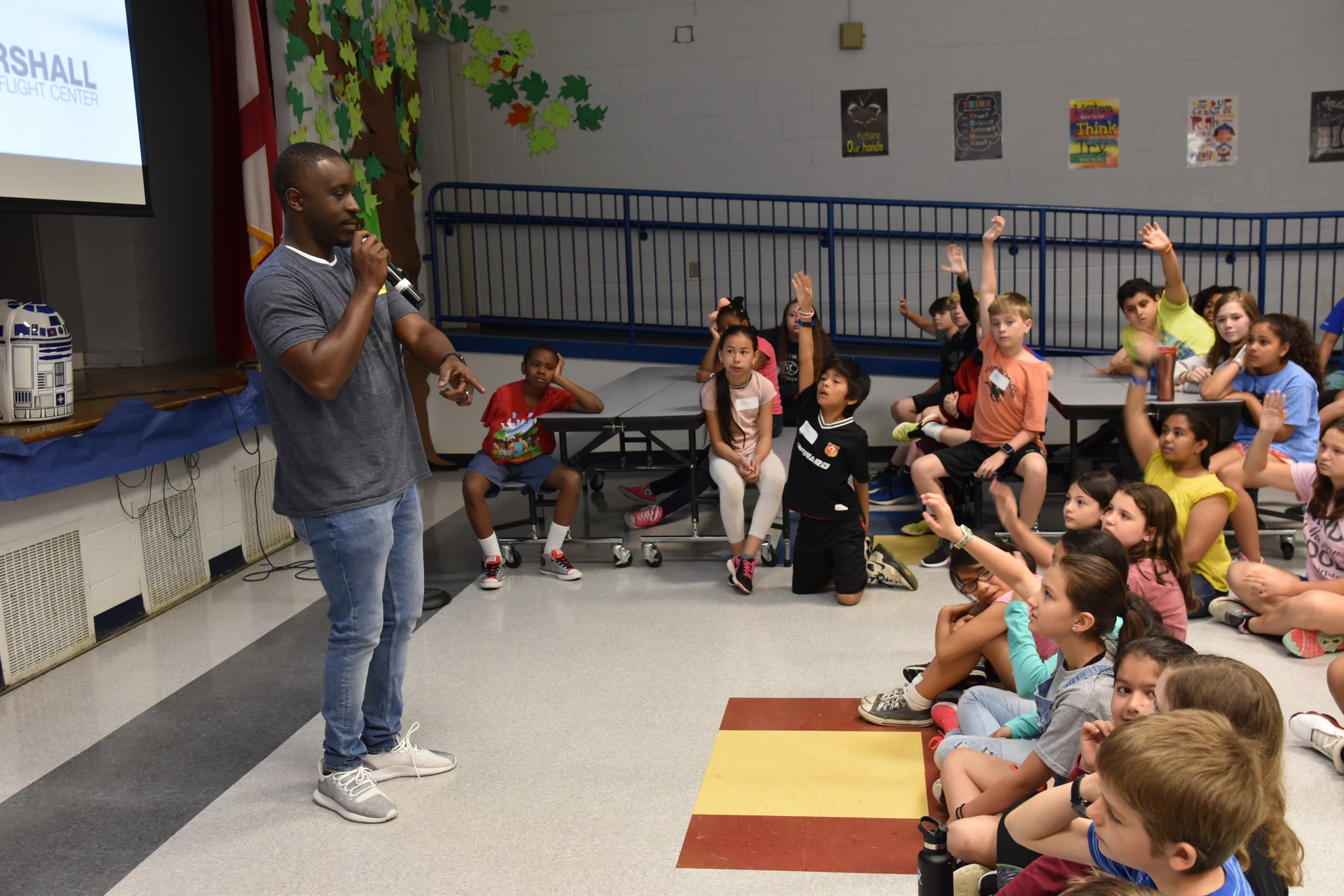
The campaign began in January with a request from Traci Ingleright, a teacher and program enrichment specialist at Gwin Elementary School in Hoover, to Cindy Wester, Marshall Speakers Bureau coordinator. Ingleright was looking for ways NASA could help her combine the “May the Fourth Be With You” celebration with special programs and activities celebrating the STEAM curricula: careers in science, technology, engineering, arts and mathematics. Ingleright predicted the city-wide education initiative would grow and similar queries could be expected from other area teachers.
Requests began to pour in — from Bluff Park Elementary and Riverchase Elementary in Hoover, to Rocky Ridge Elementary, Deer Valley Elementary and South Shades Crest Elementary in Birmingham — just to name a few. The goal of the Marshall outreach effort was simple: to engage kids on their own turf, capturing their imaginations with real-life NASA experiences and anecdotes, and colorful handouts and giveaways courtesy of Marshall’s Public Inquiries Office.
Allison Young Chambers, a project coordinator in the Safety & Mission Assurance Directorate, helped rally the services of nearly a dozen team members from that organization including Rick Burt, SMA director; David Beaman, SMA multi-program chief safety officer; and Tracy Johnson, SMA program analysis & systems integration branch chief.
“Seeing the kids so engaged during the sessions was incredible,” Chambers said. “There were so many questions following each presentation, and they were impressively relevant. Their combined interest and knowledge in NASA was outstanding. It was a such a positive event, both for the kids and our team. It was truly wonderful for them to be able to inspire these students and spread the NASA message.”
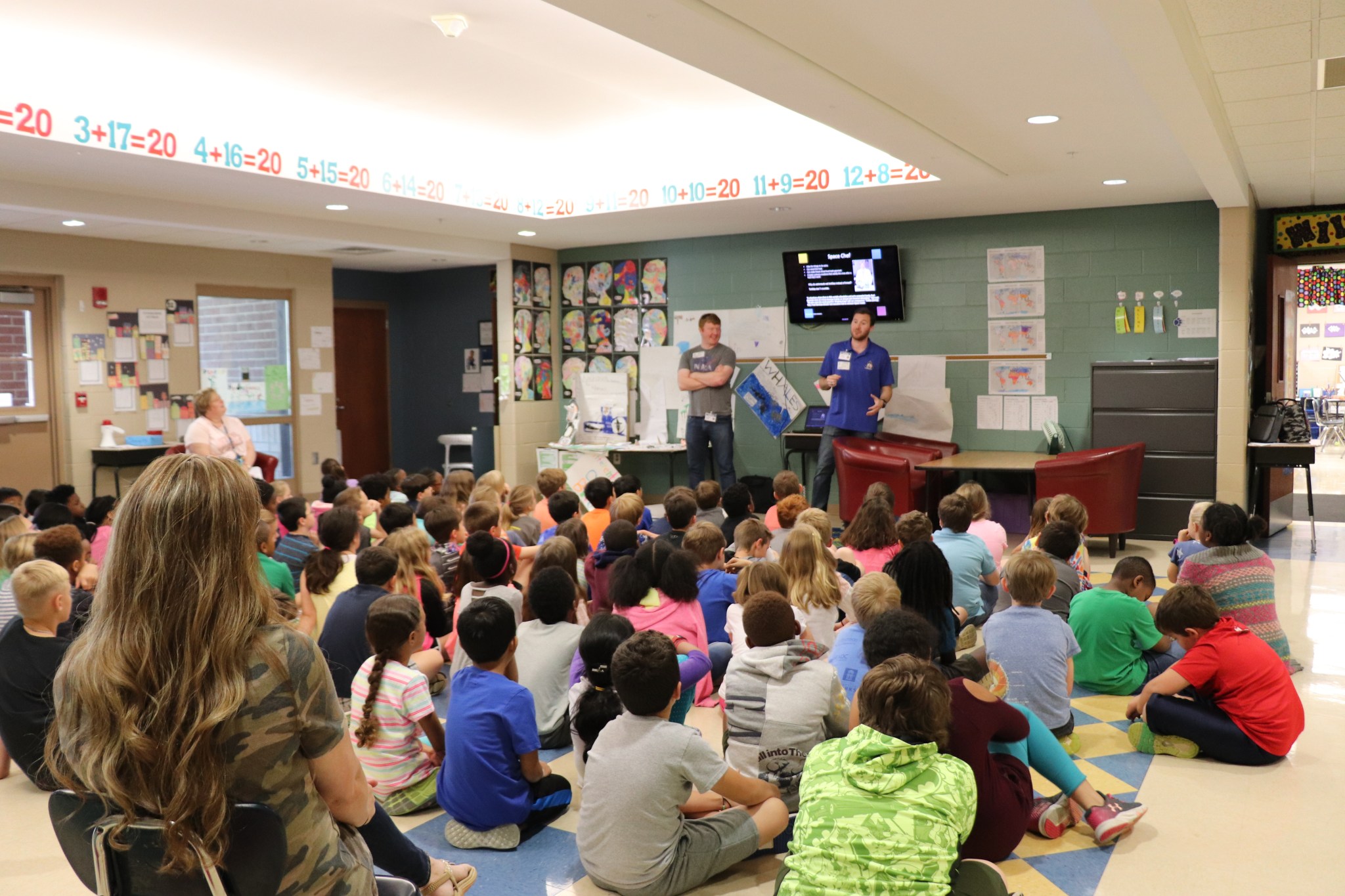
When demand for NASA representatives exceeded Chambers’ volunteers, she enlisted the help of Lisa Watkins, a project coordinator in Marshall’s International Space Station Payload and Mission Operations division. Watkins stepped up and recruited a half-dozen volunteers from her organization, the Human Exploration Development & Operations Office.
“It takes a multitude to support the NASA mission, so we talked to the students about the diverse population that supports NASA. We took each element of STEAM and talked about how we personally support the agency,” Watkins said. “Our group focused on our involvement with the International Space Station. For younger children, we employed different materials to talk about what life is like on the space station. The kids and teachers were so excited to hear our message. It was really well received. I hope they remember it for a long time.”
Among the subject matter experts travelling with the HEDO team was Nick Benjamin, a payload planning manager in Marshall’s Payload Operations Integration Center. Benjamin, who attended a small elementary school in South Alabama, said opportunities to interact with scientists and engineers didn’t come around often, so the chance to inspire a group of elementary students was one he couldn’t pass up.
“These opportunities really mean a lot to the kids and any chance I have to speak about my career and the path I took, I jump at it,” said Nick Benjamin. “We don’t realize how much of an impact we have on molding the future. NASA is full of bright minds and ideas and it’s important to reach out into the community and spread knowledge of what NASA really stands for.”
Deal, an ASRC Federal/Analytical Services employee and Marshall Star Editor, supports the Office of Strategic Analysis & Communications.
NASA Announces Winners of 2018 Student Launch Competition
By Will Bryan
The results of NASA’s 2018 Student Launch competition are tabulated, and the Vanderbilt Aerospace Design Lab team from Vanderbilt University in Nashville, Tennessee, claims top honors, which includes a check for $5,000 from NASA Marshall Space Flight Center industry partner Orbital ATK’s Propulsion Systems Division of Promontory, Utah. Vanderbilt’s first-place finish is the team’s fourth win in the last five years.
Student Launch is an annual competition that challenges competing student teams to propose, design, build and test a reusable rocket that flies to 1 mile in altitude, deploys a recovery system and returns safely to the ground, while carrying a payload of scientific or engineering value.
The top 10 in the 2018 competition are:
1. Vanderbilt Aerospace Design Lab, Vanderbilt University, Nashville, Tennessee
2. 49er Rocketry Team, University of North Carolina-Charlotte, Charlotte, North Carolina
3. River City Rocketry, University of Louisville, Louisville, Kentucky
4. Long Beach Rocketry, California State University, Long Beach, Long Beach, California
5. Cornell Rocketry Team, Cornell University, Ithaca, New York
6. Oregon State Rocketry, Oregon State University, Corvallis, Oregon
7. Cal Poly Pomona Rocketry, California State Polytechnic University, Pomona, Pomona, California
8. Bison Ballistics, Lipscomb University, Nashville, Tennessee
9. Carnegie Mellon Rocket Command, Carnegie Mellon University
10. Notre Dame Rocket Team, University of Notre Dame, South Bend, Indiana
UNC-Charlotte’s second place finish earns them $2,500 from the National Space Club – Huntsville.
The teams compete in 10 categories ranging from payload design to educational engagement. A full run-down of this year’s category winners can be found here.
“As NASA builds its next deep-space exploration rocket, the Space Launch System, it is important to inspire and help grow the next generation of engineers and explorers. Student Launch provides an opportunity for students to conduct research while also gaining invaluable workforce training,” said Katie Wallace, Student Launch manager. “It’s exciting to see the teams’ ideas and originality during the competition.”
Completing its 18th year of competition, Student Launch creates a realistic experience over an eight-month period for middle school, high school and college and university students that simulates the proposal, design, review, test and operational lifecycle of an engineering system.
Marshall’s Academic Affairs Office manages Student Launch to further NASA’s major education goal of attracting and encouraging students to pursue degrees and careers in the fields of science, technology, engineering and mathematics STEM. NASA’s Office of Education and Human Exploration and Operations Mission Directorate, as well as Orbital ATK’s Propulsion Systems Division, and the Huntsville chapter of the National Space Club provide funding and leadership for the initiative.
To view images from the week of activities, click here. Archived launch-day footage is available on NASA’s Student Launch Facebook account, here.
Bryan, an ASRC Federal/Analytical Services employee, supports the Office of Strategic Analysis & Communications.
Glenn Research Center’s Anita Laing to Share Keys to Mission Success at Shared Experiences Forum May 17
By Amanda Adams
NASA Marshall Space Flight Center team members are invited to attend a Shared Experiences Forum with Anita Liang, Safety and Mission Assurance director at NASA’s Glenn Research Center, at 11:30 a.m. May 17 in Building 4203, Room 1201.
Liang will discuss her current role and share her insight gained on mission success from her commitment to developing overarching objectives with the end game in mind. She leads and directs Glenn’s Operational Safety, Mission Assurance and Occupational Health efforts to ensure program success and workplace safety. One of her first experiences in the dissenting opinion process helped the organization grow and embrace safety and mission assurance.
The Shared Experiences Forum is a part of Marshall’s Mission Success Is In Our Hands initiative to promote and strengthen Marshall’s focus on mission, hardware and crew safety at the center. The forums are designed to engage decision makers and other team members in conversation with trusted leaders who will share their personal insights on topics related to mission assurance, what they learned and what they might do differently.
Adams, an ASRC Federal/Analytical Services employee, supports Marshall’s Office of Strategic Analysis & Communications.
Marshall Astrophysicist Colleen Wilson-Hodge to Speak at U.S. Space & Rocket Center’s Pass the Torch Series
NASA Marshall Space Flight Center Astrophysicist Colleen Wilson-Hodge will discuss the award-winning discovery of a neutron star merger by the Fermi Gamma-ray Burst Monitor team at 5:30 p.m. May 17 at the U.S. Space & Rocket Center’s Davidson Center.
The High Energy Astrophysics Division of the American Astronomical Society selected Wilson-Hodge and the Gamma-ray Burst Monitor team to receive the 2018 Bruno Rossi Prize for their role in the first joint detection of gravitational and light waves from the same cosmic event — the spectacular smashup of two neutron stars in a distant galaxy.
Wilson-Hodge has served as the principal investigator of Gamma-ray Burst Monitor since 2016. She specializes in all-sky monitoring, X-ray timing, accretion-powered pulsars and electromagnetic counterparts to gravitational waves.
Her discussion will be part of the Space & Rocket Center’s Pass the Torch Lecture Series. Open to the public, it features innovative, influential and interesting professionals from industry, academia and government speaking about their work in space, aeronautics, engineering, science research and other related fields.
Marshall to Celebrate Asian American and Pacific Islander Heritage Month
By Amanda Adams
On May 22, NASA’s Marshall Space Flight Center will celebrate the culture and contributions of team members whose Asian and Pacific Islander heritage enhances NASA’s diverse workforce, just as their work enriches the nation’s science, engineering and exploration endeavors. All Marshall team members are invited to the event, which will be held in Building 4200, Room P110 from 10 a.m.-12 p.m.
The Asian-American and Pacific Islander program, which embraces the theme, “Unite Our Vision by Working Together,” will include a keynote address by Bhavani Kakani, the founder and president of AshaKiran, A Ray of Hope. There will be an ethnic food tasting and a cultural awareness activity following the program.
Marshall’s Asian-American and Pacific Islander Heritage Month program is sponsored and organized by the Office of Diversity and Equal Opportunity.
Adams, an ASRC Federal/Analytical Services employee, supports Marshall’s Office of Strategic Analysis & Communications.
This Week in NASA History: Apollo 10 Launches – May 18, 1969
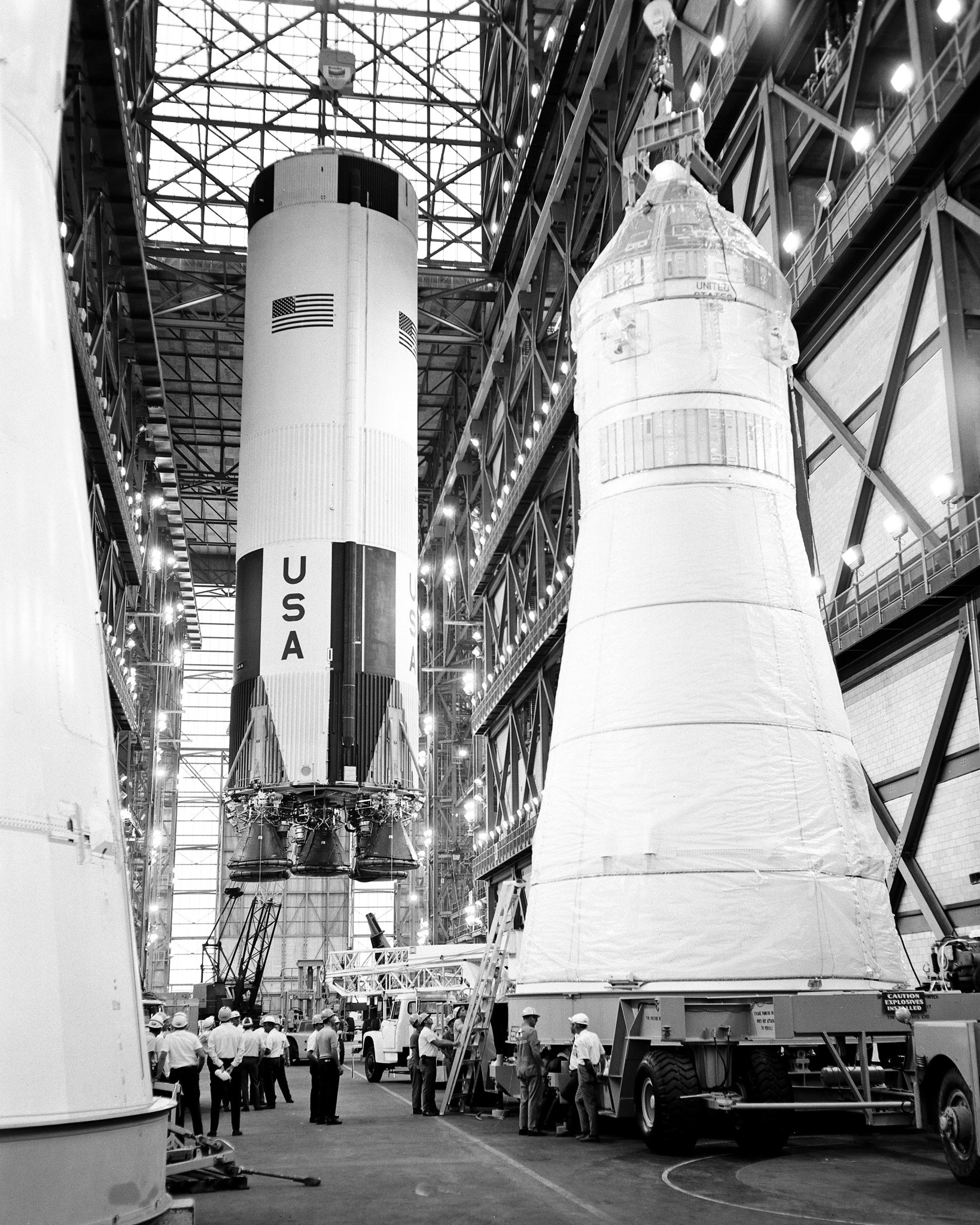
This week in 1969, Apollo 10 launched from NASA’s Kennedy Space Center. The mission encompassed all aspects of an actual crewed lunar landing, except the landing. It was the first flight of a complete, crewed Apollo spacecraft to operate in lunar orbit. Here, the first stage of the Apollo 10 Saturn V vehicle is hoisted in preparation for erection on a mobile launcher in High Bay 2 of the Vehicle Assembly Building at Kennedy. NASA’s Marshall Space Flight Center designed, developed and managed the production of the Saturn V rockets that took astronauts to the Moon. The NASA History Program is responsible for generating, disseminating and preserving NASA’s remarkable history and providing a comprehensive understanding of the institutional, cultural, social, political, economic, technological and scientific aspects of NASA’s activities in aeronautics and space. For more pictures like this one and to connect to NASA’s history, visit the Marshall History Program’s webpage. (NASA)
Obituaries
Robert C. Francis, Jr., 83, of Decatur, Alabama, died May 5. He retired from the Marshall Center in 1994 as an engineer.
Ollie Ragland, 66, of New Market, Alabama, died May 4. She retired from the Marshall Center in 2004 as a contract specialist.




























